Waste to Energy: A Green Paradigm in Solid Waste Management
Mohamad Danish Anis1 * and Tauseef Zia Siddiqui2
1
School of Mechanical,
Aerospace Civil Engineering,
University of Manchester,
Manchester
United Kingdom
2
Sustainability Specialist,
SABIC,
Jubail Industrial City,
35811
Saudi Arabia
Corresponding author Email: danishanis10@hotmail.com
DOI: http://dx.doi.org/10.12944/CWE.10.3.06
The current annual generation of municipal solid waste in India is estimated to be around 42 million tones which will rise rapidly with population growth, urbanization and improving living standards of people. The municipal solid waste (MSW) generation ranges from 0.25 to 0.66 kg/person/day with an average of 0.45 kg/person/day. In addition, large quantities of solid and liquid wastes are generated by industries. Most of the wastes generated find their way into land and water bodies. Without proper treatment, these wastes emit gases like Methane (CH4), Carbon Dioxide (CO2) etc, resulting in bad odor, emission of green house gases and increase in air and water pollution. This problem can be significantly mitigated through adoption of environment-friendly waste-to-energy technologies for the treatment and processing of wastes before disposal. It will not only reduce the quantity of wastes but also generate substantial quantity of energy. India at present is the world’s fifth biggest energy consumer and is predicted to surpass Japan and Russia to take the third place by 2030. Indian economy has shown a robust growth of around 8% in recent years and is trying to sustain this growth in order to reach goals of poverty alleviation. To achieve the required level of growth, India will need to at least triple its primary energy supply and quintuple its electrical capacity. This will force India, which already imports a majority of its oil, to look beyond its borders for energy resources. In India waste-to-energy has a potential of generating 1700 MW per person and this is scheduled to increase when more types of waste would be encompassed. At present hardly 50 MW power is being generated through waste-to-energy options. Waste combustion provides integrated solutions to the problems of the modern era by: recovering otherwise lost energy and thereby reducing our use of precious natural resources; by cutting down our emissions of greenhouse gases; and by both saving valuable land that would otherwise be destined to become landfill and recovering land once sacrificed to the products of consumerism. This paper focuses to present waste to energy as a green and sustainable solution of solid waste problem vis-à-vis its importance as renewable source of energy.
Copy the following to cite this article:
Anis M. D, Siddiqui T. Z. Waste to Energy: A Green Paradigm in Solid Waste Management. Curr World Environ 2015;10(3) DOI:http://dx.doi.org/10.12944/CWE.10.3.06
Copy the following to cite this URL:
Anis M. D, Siddiqui T. Z. Waste to Energy: A Green Paradigm in Solid Waste Management. Available from: http://www.cwejournal.org/?p=13061
Download article (pdf)
Citation Manager
Publish History
Select type of program for download
| Endnote EndNote format (Mac & Win) | |
| Reference Manager Ris format (Win only) | |
| Procite Ris format (Win only) | |
| Medlars Format | |
| RefWorks Format RefWorks format (Mac & Win) | |
| BibTex Format BibTex format (Mac & Win) |
Article Publishing History
| Received: | 2015-10-08 |
|---|---|
| Accepted: | 2015-11-11 |
Introduction
Around 42 million tonnes (115 thousand tonnes per day) and 6000 million cubic meters of liquid waste are generated every year in India. The municipal solid waste (MSW) generation ranges from 0.25 to 0.66 kg/person/day with an average of 0.45 kg/person/day (UNEP, 2011). In addition, large quantities of solid and liquid wastes are generated by industries. The increasing industrialization, urbanization and changing life patterns accompany the process of economic growth, which will give rise to an entire generation of increasing quantities of wastes that would invariably lead to increased environmental threats. But the waste management scenario continues to be grim due to inefficiency of urban local bodies that have the sole responsibility of managing the waste. As of today, open dumps are the major mode of waste disposal which requires huge land and often high transportation costs owing to its location outside the city.
Although a number of options are available for effective waste management, but the option of waste-to-energy (WTE) has caught attention of all in recent times due to its added benefit of resource generation with pollution abatement. In recent years, technologies have been developed that not only help in generating substantial quantity of decentralized energy, but also in reducing the quantity of waste for its safe disposal.
Although the WTE option has been well exploited by developed countries, but it is yet to be established fully as a viable option of waste management in India. WTE has emerged as a renewable or green source of energy which has multiple benefits. Even though there have been some failures and deficiencies, but there are some success stories too. This paper deals with all these issues in a progressive manner and establishes WTE as a viable and green paradigm in solid waste management in India.
Overview on Waste to Energy (Wte)
Waste-to-Energy or WTE is defined as gainful conversion of waste resource into energy either directly as a fuel or in form of heat or electricity. It is a “clean, reliable, renewable source of energy” (US EPA). More specifically WTE is the recovery of latent energy present in the organic fraction of the solid or liquid waste through adoption of suitable waste processing and treatment technologies.
Besides Energy recovery, WTE offers additional benefits such as
- The total quantity of waste gets reduced by nearly 60% to over 90%, depending upon the waste composition and the adopted technology.
- Reduced demand for land (already scarce in cities) that is often used for land filling.
- The cost of transportation of waste to far-away landfill sites also gets reduced proportionately.
- Net reduction in environmental pollution.
- Apart from power generation from waste, the slurry produced from Bio-methanation technology acts as a good fertilizer (DEFRA, 2014).
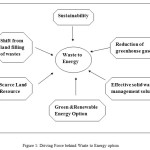 |
|
WTE Technologies
Energy can be recovered from the organic fraction of waste (biodegradable as well as non-biodegradable) basically through two methods as follows:
Thermo-chemical conversion
This process entails thermal de-composition of organic matter to produce either heat energy or fuel oil or gas; and
Bio-chemical conversion
This process is based on enzymatic decomposition of organic matter by microbial action to produce methane gas or alcohol.
Thermo-chemical conversion processes are useful for wastes containing high percentages of organic non-biodegradable matter and low moisture content. The main technological options under this category include Incineration and Pyrolysis/Gasification.
Bio-chemical conversion processes on the other hand are preferred for wastes having high percentage of organic bio-degradable (putrescible) matter and high level of moisture/ water content which aids microbial activity. The main technological option under this category is Anaerobic Digestion, also referred to as Bio-methanation. The following table summarizes the WTE technologies with their basic principles, important waste parameters and their desirable ranges.
Table 1: Desirable range of important waste parameters for technical viability of energy
recovery (Source: Manual of Municipal Solid Waste Management, GoI)
|
Waste Treatment Method
|
Basic principle |
Important Waste Parameters |
Desirable Waste Management Range |
|
Thermo-chemical conversion
-Incineration -Pyrolysis -Gasification
|
Decomposition of organic matter by action of heat |
Moisture content Organic
Volatile matter
Fixed Carbon
Total Inerts
Calorific Value (Net Calorific Value)
|
< 45 %
> 40 %
< 15 %
< 35 %
>1200 k-cal/kg
|
|
Bio-chemical conversion
-Anaerobic Digestion/ Bio-methanation
|
Decomposition of organic matter by Microbial action. |
Moisture content
Organic / Volatile matter
C/N ratio |
>50 %
> 40 %
25-30% |
WTE Potential in India:
Municipal Solid Waste (Msw)
The periodic survey results as shown in figure 2 indicate that with increasing amount of MSW in tonnes per day over a period of 15 years, we see a subsequent increase in the Mega Watts of power generated.
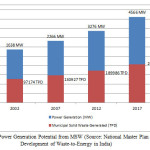 |
Figure 2: Power Generation Potential from MSW (Source: National Master Plan for Development of Waste-to-Energy in India) Click here to View figure |
Municipal Liquid Waste (Mlw)
Very much like the previous survey results in figure 2, the survey results in figure 3 shows that over time, the liquid wastes generated have also risen rapidly. However, the subsequent utilization of MLW in millions liquids per day has not been able to generate as much MW of electricity. Although steady, the statistics promise improvement in future with development of technologies
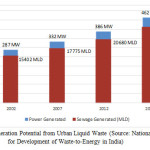 |
|
Industrial Sector Waste
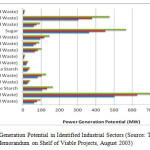 |
|
A close scrutiny to figure 4 indicates that India has enough potential for the WTE option and this potential is most likely to increase in the coming future. The challenge is to bring all these sectors under one head so that effective implementation of WTE is possible. The National Master Plan for Development of WTE in India has done a commendable job in this regard by identifying all bottlenecks in effective implementation of WTE projects.
Present Status of Wte in India
- Three projects for energy recovery from Municipal Solid Wastes with an aggregate capacity of 17.6 MW have been installed at Hyderabad, Vijayawada and Lucknow.
- Other urban waste projects include a 1 MW project based on cattle manure at Haebowal, Ludhiana; One 0.5 MW capacity project for generation of power from biogas at sewage treatment plant at Surat; One 150 kW capacity plant for vegetable market and slaughterhouse wastes at Vijayawada and one 400 kW capacity plant for production of biogas from slaughterhouse wastes at M/s Alkabeer Exports Ltd., Medak, Andhra Pradesh.
- Another 300 kW capacity project based on vegetable market waste is under commissioning at Chennai (Kalyani and Pandey, 2014).
Issues and Challenges
Overall, a total of 8 Projects for energy recovery from urban wastes with an aggregate capacity of 19.05 MW have so far been set up in the country which is nowhere near the total generation potential from urban waste. Although the government of India has provided many subsidies and incentives, but the projects have either not come up or have failed.
Subsidy
The MNRE grants approximately 340,000 to 680,000 US dollars per Mw of renewable energy as incentive to industry, attracting several foreign and national companies. (Source: Feb 22 (IPS) By Keya Acharya). Recent media reports also show that many projects which came up after pumping a lot of subsidy from the government have failed due to complex reasons.
Failures
Since 1994, about 33 MW WTE proposals worth three million dollars of investment as subsidy were not started and two out of three projects begun for generating of 17.6 MW power in Delhi, Lucknow, Vijayawada and Hyderabad have been failures (Source: Feb 22 (IPS) By Keya Acharya.
Environmental Issues
Another rising concern is about the air pollution which is caused due to the incineration of waste which is notorious for releasing toxic pollutants like dioxins and furans. Preventive standards to cope with such intoxicants have not yet been made available in India. Additionally, the disposal of ash and inert material remains after burning continues to be an area of concern
All these throw light on the fact that the path of development of WTE in India has encountered a lot of limitations, constraints and failures. The benefit of utilizing a green and renewable source of energy has not been gained in India yet. There is an immediate need to study all the bottlenecks and utilize the potential of WTE to its fullest. With regards to these issues, the government of India has made a ‘National Master Plan for Development of Waste-to-Energy in India’ which will guide the further development of WTE in India.
Table 2: Limitations/Constraints and Reasons for failures of WTE Projects
|
Limitations/Constraints |
Reasons for failures |
|
|
Solutions
WTE promotion needs a four-Tier Approach to resolve all issues and coordination of all stakeholders and institutions so that these projects run smoothly and reduce the burden on non-renewable sources of energy.
Table 2.1: Four-Tier approach to WTE promotion
|
Tier |
Issues |
Institutions/Group Involved |
|
Social |
|
|
|
Legal |
|
|
|
Technological |
|
|
|
Financial |
|
|
WTE alone cannot solve all problems of solid waste management in India as characteristics of waste vary widely and in some cases WTE may not be a feasible option.
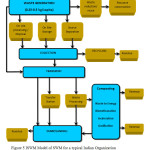 |
|
Thus, for complete solution of waste management integrated solid waste management approach has to be applied which takes into account all options and gives the best possible option of solid waste management based on local conditions and waste scenario. Above is the ISWM model that can be followed for holistic approach of solid waste management.
Conclusion
Recent failures of WTE Projects do not conclude that there is no future of WTE in India. More over these failures have resulted due to lack of research that was put into the project. Others issues like environmental concerns too can be mitigated through advanced air pollution control systems. Technologies are gradually coming up which are having high efficiency and little emissions like plasma arc technology, microwave destruction, laser destruction, etc. We must not forget that WTE is a green and renewable source of energy as well as it provides a solution of our waste management. Thus, the double benefits can’t be ignored as India is highly dependent on oil imports and dwindling coal reserves to meet its energy demand. Waste to Energy will be emerging as a green paradigm in solid waste management in India in coming future and too as a clean, green and renewable source of energy.
References
- CPHEEO (2000), Manual on Municipal Solid Waste Management, Central Public Health and Environmental Engineering Organization, Ministry of Urban Development, New Delhi,15, ,p.262-265
- MNES (2003), Executive Summary, Technical Memorandum on Waste-to-Energy Technologies, National Master Plan for Development of Waste-to-Energy in India, National Bio-energy Board (NBB),Ministry of Non-Conventional Energy Sources, New Delhi, p. i-v
- GGTIE (1997), Municipal solid waste mass burn: Clean energy from Municipal solid waste: A vital bioenergy technology for the 21st century. IEA bioenergy Task, XIV, ETSU, Hawell, UK
- Siddiqui, T.Z.(2006), M.Tech thesis report, Department of Environmental Science and Engg., Indian School of Mines, Dhanbad, India
- Ministry of Non-Conventional Energy Sources, Government of India, available at http://mnes.nic.in/
- Acharya, Keya (Feb22, 2007), ENVIRONMENT-INDIA: Converting Waste to Energy - Not So Green, IPS magazine.
- June 12, 2005, A deadly recipe, The Financial Express.
- Kalyani and Pandey (2014) - http://www.sciencedirect.com/science/article/pii/S1364032113007697






